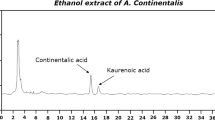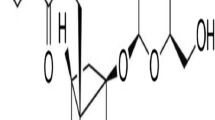Abstract
Background
Cognitive inflexibility is one of the major clinical symptoms of post-traumatic stress disorder (PTSD). Studies have examined the impact of traumatic events on anxiety. However, there were limited reports on the effect of traumatic episodes on cognitive flexibility. Therefore, animal models developing cognitive inflexibility would provide new insight of pathophysiology and pharmacotherapy of PTSD.
Methods
Male Wistar rats were subjected to stress–re-stress (SRS) procedure by restraining them for 2 h followed by foot shock (FS) and halothane exposure on day 2 (D-2). Then, the rats were exposed every week to FS as re-stress cue up to D-32. Donepezil (3 mg/kg; po) and sertraline (10 mg/kg; po) dosing was started from D-8 and continued up to D-32.
Results
SRS exposure caused cognitive inflexibility by producing deficits in intra-dimension (ID) and extra-dimension (ED) set-shifting which was significantly attenuated by donepezil. However, sertraline mitigated only ID shift in SRS-subjected rats. SRS-induced PTSD-like symptoms such as fear response, anxiety-like behaviour and cognitive deficits were attenuated by both donepezil and sertraline. Donepezil did not modulate the SRS-induced hypothalamic–pituitary–adrenal (HPA) axis dysfunction and activation of serotonergic and nor-adrenergic system. Interestingly, exposure of SRS caused a decrease in acetylcholine level and increase in acetylcholine esterase activity in prefrontal cortex (PFC) and hippocampus (HIP) which was only mitigated by donepezil. Donepezil significantly attenuated SRS-induced down-regulation of choline-acetyl transferase and α-7 nicotinic acetylcholine receptor expressions in PFC and HIP.
Conclusion
Cognitive inflexibility is developed in the SRS model along with other PTSD-like symptoms which were attenuated by donepezil.








Similar content being viewed by others
Abbreviations
- ACh:
-
Acetylcholine
- AChE:
-
Acetylcholine esterase
- ACTH:
-
Adrenocorticotropic hormone
- α-7nAChR:
-
Alpha-7 nicotinic acetylcholine receptor
- AMY:
-
Amygdala
- ChAT:
-
Choline-acetyl transferase
- CORT:
-
Corticosterone
- ED:
-
Extra-dimensional shift
- EPM:
-
Elevated plus maze
- FS:
-
Foot shock
- HIP:
-
Hippocampus
- HPA axis:
-
Hypothalamic–pituitary–adrenal axis
- ID:
-
Intra-dimensional shift
- MANOVA:
-
Multivariate analysis of variance
- NE:
-
Norepinephrine
- PFC:
-
Prefrontal cortex
- PTSD:
-
Post-traumatic stress disorder
- 5-HT:
-
Serotonin
- SRS:
-
Stress–re-stress
- SSRIs:
-
Selective serotonin re-uptake inhibitors
References
Hapke U, Schumann A, Rumpf H-J, John U, Meyer C. Post-traumatic stress disorder. Eur Arch Psychiatry Clin Neurosci. 2006;256:299–306.
Ramaswamy S, Driscoll D, Smith LM, Bhatia SC, Petty F. Failed efficacy of ziprasidone in the treatment of post-traumatic stress disorder. Contemp Clin Trials Commun. 2016;2:1–5.
Thomas E, Stein DJ. Novel pharmacological treatment strategies for posttraumatic stress disorder. Exp Rev Clin Pharmacol. 2017;10:167–77.
Berger W, Mendlowicz MV, Marques-Portella C, Kinrys G, Fontenelle LF, Marmar CR, et al. Pharmacologic alternatives to antidepressants in posttraumatic stress disorder: a systematic review. Prog Neuropsychopharmacol Biol Psychiatry. 2009;33:169–80.
Ben-Zion Z, Fine NB, Keynan JN, Admon R, Green N, Halevi M, et al. Cognitive flexibility predicts PTSD symptoms: observational and interventional studies. Front Psychiatry. 2018;9:477.
Keith J, Velezmoro R, O’Brien C. Correlates of cognitive flexibility in veterans seeking treatment for posttraumatic stress disorder. J Nerv Ment Dis. 2015;203:287–93.
Jin C, Qi R, Yin Y, Hu X, Duan L, Xu Q, et al. Abnormalities in whole-brain functional connectivity observed in treatment-naive post-traumatic stress disorder patients following an earthquake. Psychol Med. 2014;44:1927–36.
Birrell JM, Brown VJ. Medial frontal cortex mediates perceptual attentional set shifting in the rat. J Neurosci. 2000;20:4320–4.
Zhao D, Xu X, Pan L, Zhu W, Fu X, Guo L, et al. Pharmacologic activation of cholinergic alpha7 nicotinic receptors mitigates depressive-like behavior in a mouse model of chronic stress. J Neuroinflamm. 2017;14:234.
George SA, Rodriguez-Santiago M, Riley J, Abelson JL, Floresco SB, Liberzon I. Alterations in cognitive flexibility in a rat model of post-traumatic stress disorder. Behav Brain Res. 2015;286:256–64.
Herrmann N, Chau SA, Kircanski I, Lanctot KL. Current and emerging drug treatment options for Alzheimer’s disease. Drugs. 2011;71:2031–65.
Haydar SN, Dunlop J. Neuronal nicotinic acetylcholine receptors-targets for the development of drugs to treat cognitive impairment associated with schizophrenia and Alzheimer’s disease. Curr Top Med Chem. 2010;10:144–52.
Takada-Takatori Y, Kume T, Ohgi Y, Fujii T, Niidome T, Sugimoto H, et al. Mechanisms of α7-nicotinic receptor up-regulation and sensitization to donepezil induced by chronic donepezil treatment. Eur J Pharmacol. 2008;590:150–6.
Krishnamurthy S, Garabadu D, Joy KP. Risperidone ameliorates post-traumatic stress disorder-like symptoms in modified stress re-stress model. Neuropharmacology. 2013;75:62–77.
Garabadu D, Ahmad A, Krishnamurthy S. Risperidone attenuates modified stress–re-stress paradigm-induced mitochondrial dysfunction and apoptosis in rats exhibiting post-traumatic stress disorder-like symptoms. J Mol Neurosci. 2015;56:299–312.
Qin S, Hermans EJ, van Marle HJ, Luo J, Fernández G. Acute psychological stress reduces working memory-related activity in the dorsolateral prefrontal cortex. Biol Psychiatry. 2009;66:25–32.
Wang W, Liu Y, Zheng H, Wang HN, Jin X, Chen YC, et al. A modified single-prolonged stress model for post-traumatic stress disorder. Neurosci Lett. 2008;441:237–41.
Liberzon I, Krstov M, Young EA. Stress-restress: effects on ACTH and fast feedback. Psychoneuroendocrinology. 1997;22:443–53.
Prajapati SK, Singh N, Garabadu D, Krishnamurthy S. A novel stress re-stress model: Modification of re-stressor cue induces long-lasting post-traumatic stress disorder-like symptoms in rats. Int J Neurosci. 2020. https://doi.org/10.1080/00207454.2019.1711078.
Yehuda R, Southwick SM, Nussbaum G, Wahby VS, Giller EL, Mason JW. Low urinary cortisol excretion in patients with posttraumatic stress disorder. J Nerv Ment Dis. 1990. https://doi.org/10.1097/00005053-199006000-00004.
Pattanashetti LA, Taranalli AD, Parvatrao V, Malabade RH, Kumar D. Evaluation of neuroprotective effect of quercetin with donepezil in scopolamine-induced amnesia in rats. Indian J Pharmacol. 2017;49:60.
Santiago RM, Zaminelli T, Bassani TB, Boschen SL, Lima MM, Da Cunha C, et al. The mechanism of antidepressant-like effects of piroxicam in rats. J Pharmacol Pharmacother. 2015;6:7.
Kumar P, Kumar A. Possible role of sertraline against 3-nitropropionic acid induced behavioral, oxidative stress and mitochondrial dysfunctions in rat brain. Prog Neuropsychopharmacol Biol Psychiatry. 2009;33:100–8.
Prajapati SK, Dangi DS, Krishnamurthy S. Repeated caffeine administration aggravates post-traumatic stress disorder-like symptoms in rats. Physiol Behav. 2019;211:112666.
Paxinos G, Ashwell KW. Atlas of the developing rat nervous system. London: Academic Press; 2018.
Mikics E, Baranyi J, Haller J. Rats exposed to traumatic stress bury unfamiliar objects—a novel measure of hyper-vigilance in PTSD models? Physiol Behav. 2008;94:341–8.
Ojha R, Sahu AN, Muruganandam A, Singh GK, Krishnamurthy S. Asparagus recemosus enhances memory and protects against amnesia in rodent models. Brain Cogn. 2010;74:1–9.
Dębiec J, Bush DE, LeDoux JE. Noradrenergic enhancement of reconsolidation in the amygdala impairs extinction of conditioned fear in rats—a possible mechanism for the persistence of traumatic memories in PTSD. Depress Anxiety. 2011;28:186–93.
López J, Imperial S, Valderrama R, Navarro S. An improved Bradford protein assay for collagen proteins. Clin Chim Acta. 1993;220:91–100.
Mousum SA, Ahmed S, Gawali B, Kwatra M, Ahmed A, Lahkar M. Nyctanthes arbor-tristis leaf extract ameliorates hyperlipidemia-and hyperglycemia-associated nephrotoxicity by improving anti-oxidant and anti-inflammatory status in high-fat diet–streptozotocin-induced diabetic rats. Inflammopharmacology. 2018;26:1415–28.
Fani N, Kitayama N, Ashraf A, Reed L, Afzal N, Jawed F, et al. Neuropsychological functioning in patients with posttraumatic stress disorder following short-term paroxetine treatment. Psychopharmacol Bull. 2009;42:53.
Tait DS, Bowman EM, Neuwirth LS, Brown VJ. Assessment of intradimensional/extradimensional attentional set-shifting in rats. Neurosci Biobehav Rev. 2018;89:72–84.
Brady K, Pearlstein T, Asnis GM, Baker D, Rothbaum B, Sikes CR, et al. Efficacy and safety of sertraline treatment of posttraumatic stress disorder: a randomized controlled trial. JAMA. 2000;283:1837–44.
Steckler T, Sahgal A. The role of serotonergic-cholinergic interactions in the mediation of cognitive behaviour. Behav Brain Res. 1995;67:165–99.
Su D, Zhao Y, Wang B, Xu H, Li W, Chen J, et al. Isoflurane-induced spatial memory impairment in mice is prevented by the acetylcholinesterase inhibitor donepezil. PLoS ONE. 2011;6:e27632.
Hasselmo ME, Wyble BP, Wallenstein GV. Encoding and retrieval of episodic memories: role of cholinergic and GABAergic modulation in the hippocampus. Hippocampus. 1996;6:693–708.
Kakinuma Y, Akiyama T, Sato T. Cholinoceptive and cholinergic properties of cardiomyocytes involving an amplification mechanism for vagal efferent effects in sparsely innervated ventricular myocardium. FEBS J. 2009;276:5111–25.
Shimohama S, Kihara T. Nicotinic receptor–mediated protection against β-amyloid neurotoxicity. Biol Psychiatry. 2001;49:233–9.
Corradi J, Bouzat C. Understanding the bases of function and modulation of α7 nicotinic receptors: implications for drug discovery. Mol Pharmacol. 2016;90:288–99.
Gonzalez P, Martinez KG. The role of stress and fear on the development of psychopathology. Psychiatric Clin N Am. 2014;37:535.
Millan MJ, Agid Y, Brüne M, Bullmore ET, Carter CS, Clayton NS, et al. Cognitive dysfunction in psychiatric disorders: characteristics, causes and the quest for improved therapy. Nat Rev Drug Discov. 2012;11:141.
Hannibal KE, Bishop MD. Chronic stress, cortisol dysfunction, and pain: a psychoneuroendocrine rationale for stress management in pain rehabilitation. Phys Ther. 2014;94:1816–25.
Kasckow J, Baker D, Geracioti T Jr. Corticotropin-releasing hormone in depression and post-traumatic stress disorder. Peptides. 2001;22:845–51.
Barden N, Reul J, Holsboer F. Do antidepressants stabilize mood through actions on the hypothalamic-pituitary-adrenocortical system? Trends Neurosci. 1995;18:6–11.
Krystal JH, Neumeister A. Noradrenergic and serotonergic mechanisms in the neurobiology of posttraumatic stress disorder and resilience. Brain Res. 2009;1293:13–23.
Karanges E, Li KM, Motbey C, Callaghan PD, Katsifis A, McGregor IS. Differential behavioural and neurochemical outcomes from chronic paroxetine treatment in adolescent and adult rats: a model of adverse antidepressant effects in human adolescents? Int J Neuropsychopharmacol. 2011;14:491–504.
Shin LM, Rauch SL, Pitman RK. Amygdala, medial prefrontal cortex, and hippocampal function in PTSD. Ann N Y Acad Sci. 2006;1071:67–79.
Acknowledgements
SKP is thankful to teaching assistantship from IIT-(BHU) Varanasi
Author information
Authors and Affiliations
Contributions
SK and SKP conducted the study, analysed the results, wrote and checked the manuscript.
Corresponding author
Ethics declarations
Conflict of interest
Declaration from the author that there is no conflict of interest.
Ethical approval
All animal experiments were performed according to the principle guidelines of the National Institute of Health Guidelines (publication number 85–23, revised 2013), on animal care experimentation. All the experimental methods were approved by the Central Animal Ethical Committee of Banaras Hindu University, Varanasi, India (Approval No. Dean/2016/CAEC/324).
Additional information
Publisher's Note
Springer Nature remains neutral with regard to jurisdictional claims in published maps and institutional affiliations.
Supplementary Information
Below is the link to the electronic supplementary material.
Rights and permissions
About this article
Cite this article
Prajapati, S.K., Krishnamurthy, S. Development and treatment of cognitive inflexibility in sub-chronic stress–re-stress (SRS) model of PTSD. Pharmacol. Rep 73, 464–479 (2021). https://doi.org/10.1007/s43440-020-00198-9
Received:
Revised:
Accepted:
Published:
Issue Date:
DOI: https://doi.org/10.1007/s43440-020-00198-9




